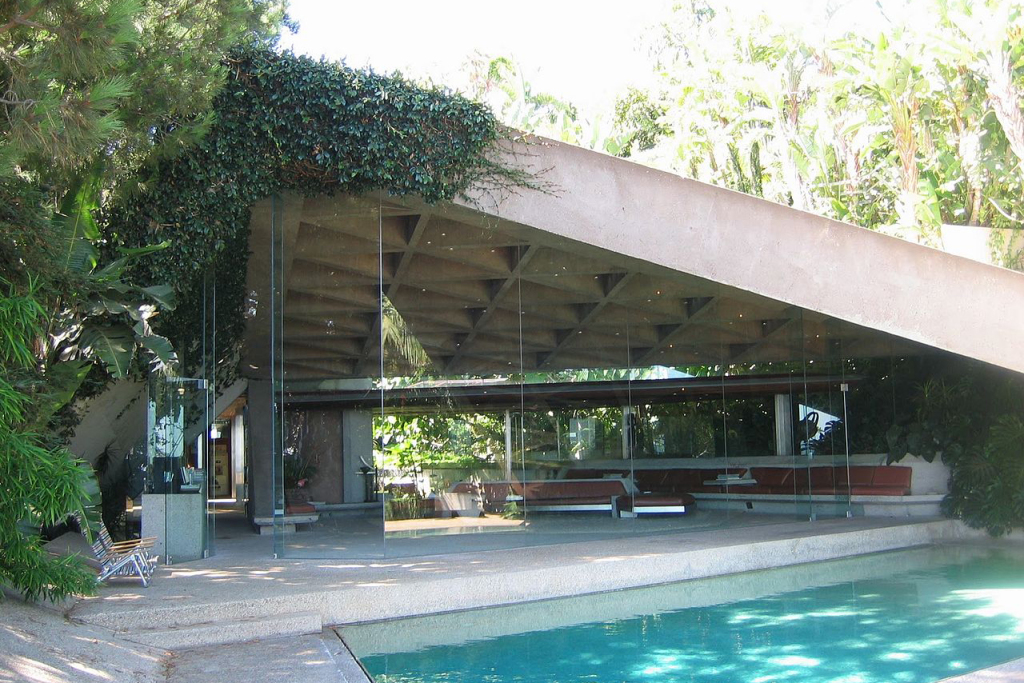James Goldstein recalls Jack Nicholson directing traffic with a cocktail in his hand outside the notorious party house that he donated to LACMA.
Now that businessman James Goldstein has donated his iconic mid-century cliff-side aerie, the Sheats-Goldstein House, to LACMA, regular folk will finally get a look at the tony residence where Rihanna celebrated her birthday, Mark Ronson and Jamie xx held their pre-Grammy party, NBA great Stephen Curry hung out for a whole day after the commercial he was shooting wrapped and, yes, where the Dude kicked back with a white Russian, courtesy of pornographer Jackie Treehorn in The Big Lebowski.
A house acquires a legacy like this for two reasons — one, Sheats-Goldstein is a landmark structure that has served as a magnet for architects since John Lautner built it in 1963, and two, Goldstein is a guy who likes to share.
“No patron, no project,” LACMA CEO Michael Govan told gathered press Feb. 19 of the donation worth an estimated $40 million, with Goldstein — in his trademark snakeskin hat and leather ensemble — lurking nearby. “Without the patron, artists cannot work.”
Goldstein, who reportedly made his fortune in real estate investments, had no trouble finding work for Lautner. He first hired the architect in 1979, employing him off and on up until his death in 1994. Adjustments to the Beverly Crest home included replacing formica-and-plywood cabinets in the living room, and dispensing with steel mullions that crisscrossed the view from the living room.
Having trained with Frank Lloyd Wright at Taliesin, Lautner oversaw construction of some of Wright’s most famous residences, including the George Sturges House in Brentwood, which failed to find a buyer at a Feb. 21 auction.
Though hardly an example of Wright’s Usonian concepts, the Sheats-Goldstein House exercises many pervading ideas of its time, working harmoniously with the cliff face, barely discernible from the landscape even when you’re right on top of it. Moving through the interior one experiences a subtle flow of indoors and outdoors, with receding skylights in the kitchen and dining area for meals under the stars.
Lautner’s work from the same period includes the space-age Chemosphere House overlooking the San Fernando Valley, as well as the Garcia House, another cliff-side dwelling currently owned by John McIlwee of entertainment management firm Shephard McIlwee and Tingloff. After acquiring it in 2002, McIlwee and his partner, DreamWorks executive Bill Damaschke, put $1 million into restoring the unique Hollywood Hills home often called “The Rainbow House” for its arcing parabolic roof and red and blue stained-glass windows.
In 1992, WGA President Howard Rodman and Anne Friedberg purchased Lautner’s Zahn House and hired the architect to renovate the 1957 structure. Rodman, McIlwee and Goldstein come from a tradition of industry professionals who have become reliable stewards for classic homes. An institution like LACMA could not afford to accept Goldstein's donation of the house without $17 million preservation endowment that comes with it. Maintenance is always an issue, even if the building is mostly made of concrete, like Sheats-Goldstein.
“I have a cantilevered glass terrace down below the house,” the owner told The Hollywood Reporter about the one time he regretted opening his home to a photo shoot. “A model was posing on the terrace with a bottle of perfume and she dropped it, causing the glass to crack. It took $75,000 expenditure to restore it to the way it was.”
With so much traffic in the house, there’s bound to be damage, which is why he built an alternative party space, Club James, across the driveway. Designed by Lautner protege Duncan Nicholson, it features offices, a meeting room and a private nightclub with spectacular views.
Now in his 70s, Goldstein is happy to host parties at Club James, even when he’s not attending, whether it be for architects and curators from the Iconic Houses Conference, which had its Feb. 19 closing night fete there, or for Hollywood VIPs. “I can tell you about a party I had many years ago that Jack Nicholson attended,” he recalls of the days before Club James. “A couple blocks away from my house there was a huge traffic jam with people trying to get to the party, and Nicholson got out of the car and directed traffic with a drink in his hand.”
These days, Club James helps keep the partying more sensible. An infinity lap pool and entertainment center are currently under construction, and on the roof is an infinity tennis court adjacent to the site of a planned guesthouse to replace the original one by Lautner, torn down long ago. Despite the changes surrounding the house (dressing rooms for film and photo shoots were added to the entranceway), few alterations have been done to the actual structure without Lautner’s involvement. “I’ve always aimed for the aesthetics more than the effect,” offers Goldstein. "Hopefully I was able to achieve both of them together."
At LACMA, Govan is overjoyed at the donation, which includes an art collection with works by Ed Ruscha, Kenny Scharf and a skyscape installation by light-and-space sculptor, James Turrell. Tours will be available by appointment on a limited basis for as long as Goldstein resides there.
“As he said, 'If you give a paintings to a museum, why shouldn’t you give a house to a museum?'” Govan said, recalling Goldstein's words to him as he stood silhouetted by the breathtaking view. “Thirty-five years so far, working on the house, and more to come.”



















